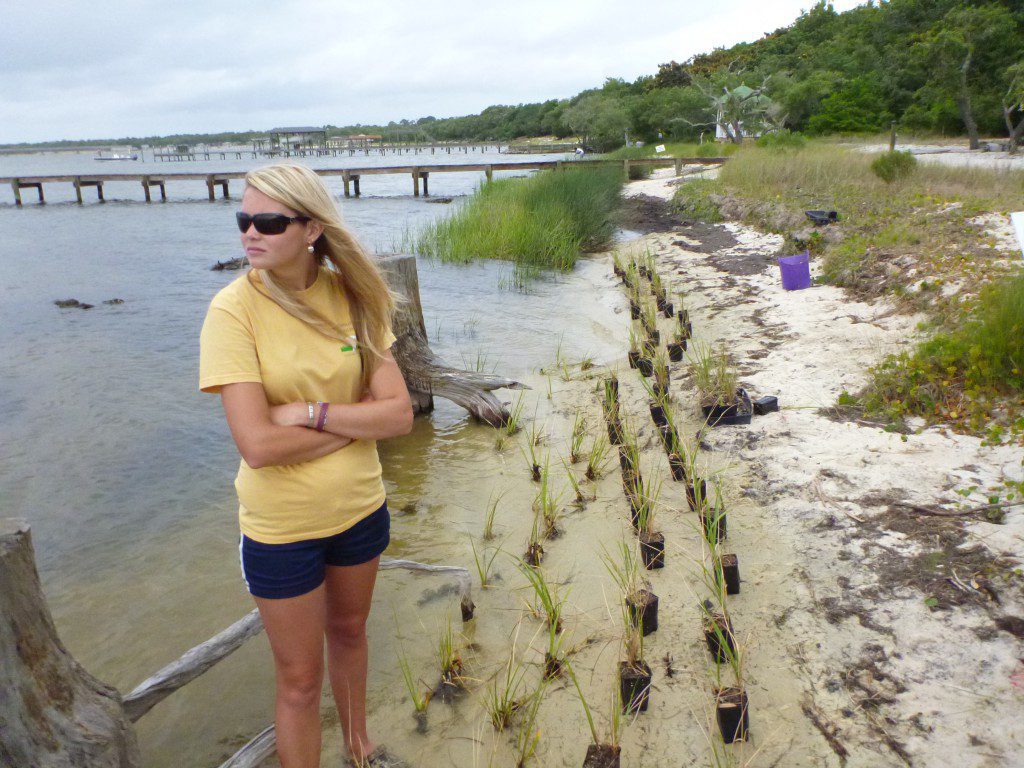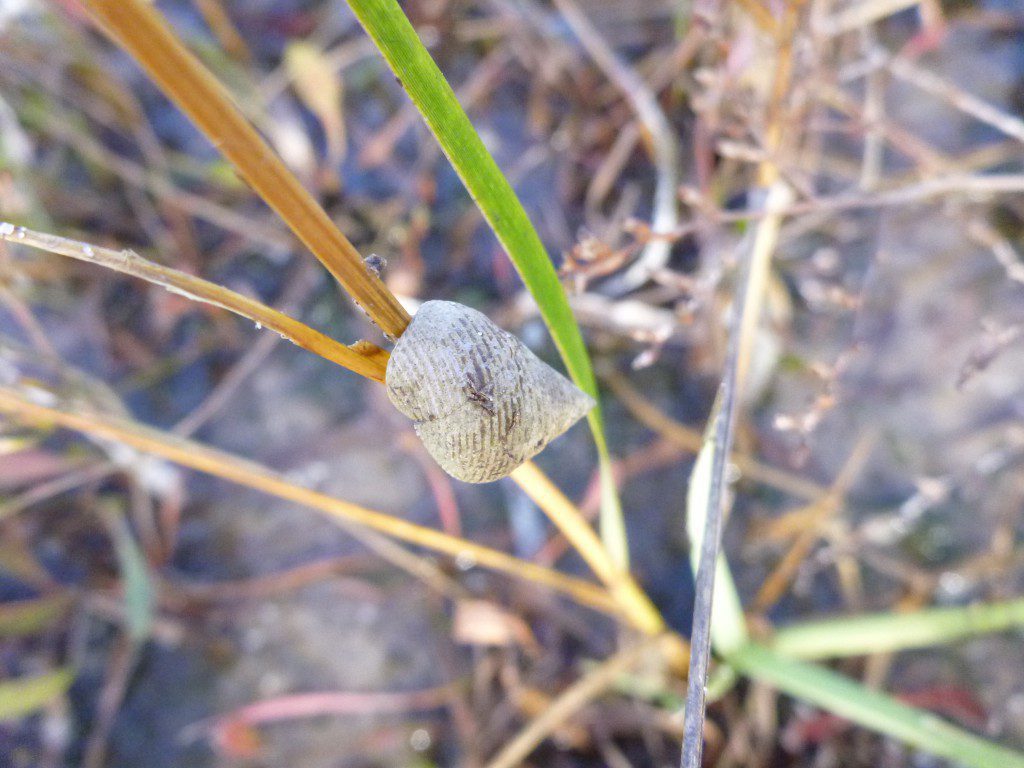2 Minute Video: Do Marshes Combat Die-Off Through Biodiversity?
Data on “cold” and “warm” episodes compiled by NOAA and the National Weather Service correlate warm episodes with events Randall and David care about: the ruining of oyster reefs south of Saint Augustine by crown conchs in 2005, the Apalachicola oyster fishery crash last year, and the die-off of salt marsh habitats at the turn of the millennium. These episodes are part of a normal climatological cycle, though recent droughts during warm years have been severe.
Dr. Randall Hughes FSU Coastal & Marine Lab/Northeastern University
![image[6] Mineral Springs Seafood's Dusty Murray empties a crab trap by a salt marsh off of Ochlockonee Bay. Blue crabs are one of the many animals that make use of the salt marsh habitat.](https://blog.wfsu.org/blog-coastal-health/wp-content/uploads/2013/06/image6-768x1024.jpg)
Mineral Springs Seafood’s Dusty Murray empties a crab trap by a salt marsh off of Ochlockonee Bay. Blue crabs are one of the many animals that make use of the salt marsh habitat.
 We’re going to shift our attention a bit to another intriguing intertidal habitat – the salt marsh. We’ve focused a lot recently on oysters, and how David is applying what we’ve learnedfrom our oyster research the last few years to try to understand the crash of the Apalachicola oyster fishery. There is something inherently interesting and fascinating about oysters, despite the fact that they look a lot like not much more than really sharp rocks. And of course, there is urgency to understand the oyster problems in Apalachicola because of the very real and immediate human costs associated with the fishery collapse.But now, my goal is to convince you that the salt marsh is just as fascinating as oyster reefs, even if it is not a highly visible fishery in trouble. Think of me as the parent trying to get you to appreciate your broccoli, after David already gave you your chocolate cake. I’m going to get you to LIKE your broccoli.
We’re going to shift our attention a bit to another intriguing intertidal habitat – the salt marsh. We’ve focused a lot recently on oysters, and how David is applying what we’ve learnedfrom our oyster research the last few years to try to understand the crash of the Apalachicola oyster fishery. There is something inherently interesting and fascinating about oysters, despite the fact that they look a lot like not much more than really sharp rocks. And of course, there is urgency to understand the oyster problems in Apalachicola because of the very real and immediate human costs associated with the fishery collapse.But now, my goal is to convince you that the salt marsh is just as fascinating as oyster reefs, even if it is not a highly visible fishery in trouble. Think of me as the parent trying to get you to appreciate your broccoli, after David already gave you your chocolate cake. I’m going to get you to LIKE your broccoli.
The “broccoli” in this scenario is none other than salt marsh cordgrass, Spartina alterniflora, a familiar character on this blog. In addition to oysters, cordgrass has been the focus of most of my research in FL. Why, you may ask? Why study broccoli when you could be studying chocolate cake all the time? The parent in me is tempted to use the catch-all phrase “Because it’s good for you!” But I’ll refrain, and instead give you a few actual reasons:
1. Oyster and cordgrass really aren’t all that different.
What do oysters and cordgrass have in common? At first glance, it may not seem like much. Oysters are animals; cordgrass is a plant. Oysters are tasty (depending on your palette); cordgrass is inedible. Oysters support a community of fishermen, at least in better times; cordgrass doesn’t.
Except this last distinction, which may seem intuitive, is not actually true. Cordgrass, and salt marshes more generally, support a wide range of fishery species including blue crabs (as you can see in the video), mullet, and sea trout. Studies in Florida estimate that marshes provide up to nearly $7000 per acre for recreational fishing alone. And like oysters, salt marshes provide more benefits for us than simply what we can eat, including protection from storms, increased water quality, and erosion control.
2. Plants are cool.
I know I don’t have to convince any of you gardeners out there about the beauty of plants. Give them a little sunshine, some nutrients, and a little water, and they do their thing. And cordgrass can even manage in salt water! There’s something to be said for low maintenance study organisms.

A year ago, that full-bodied marsh in the background looked just like the rows of small cordgrass shoots leading up to it. Both were planted by Laurel Hill School students as part of the Choctawhatchee Basin Alliance’s Grasses in Classes program.
Not only that, but you can plant a single cordgrass stem, leave it alone for a few months, and return to find that it has expanded to 20 stems, all from the same individual! (Or, if you’re lucky enough to be part of Grasses in Classes, you can admire successive years of growth from single transplants.) This “clonal expansion” is impressive, and it makes answering some of the research questions that I’m interested in pretty easy to address – I can test whether some individuals are better at expanding than others, or whether they withstand stresses like grazing better, or whether having a mix of individuals is better than lots of stems of the same individual. I can ask these questions using oysters too, but it is a lot more difficult. Even we ‘eat your vegetables’ advocates like taking the easy way out sometimes.
3. Marshes are in trouble too.
Although not in the headlines of the local papers at the moment, cordgrass has experienced significant declines in the Gulf of Mexico in the past, and salt marsh loss is a historic and ongoing problem in many parts of the world. And in some cases, the same problem can contribute to the loss of marshes and oysters. For instance, drought has been linked to salt marsh die-off in the Gulf, and drought-induced stress can make the plants more sensitive to other stresses such as grazing by snails. (As we’ve discussed before, drought and increased salinities can also make oysters more sensitive to predators and disease.) Because of the many benefits that marshes provide, it is in our best interest to understand the causes of these losses and try to prevent / counteract them.
For these reasons and more, I’ve been conducting lots of experiments the past few years to (a) understand what factors increase / decrease how sensitive cordgrass is to it’s major grazer, the marsh periwinkle, and (b) figure out if having more cordgrass individuals (or “genotypes”) makes the marsh less sensitive to change. We’ll highlight these experiments in the coming weeks as part of our quest to spark your fascination with the salt marsh!
Music in the video by Cross(o)ver. The maps used in the animation were generated by the National Drought Mitigation Center. Special thanks to Mineral Springs Seafood for taking us along as they emptied their crab traps.
This material is based upon work supported by the National Science Foundation under Grant Number 1161194. Any opinions, findings, and conclusions or recommendations expressed in this material are those of the author(s) and do not necessarily reflect the views of the National Science Foundation.

